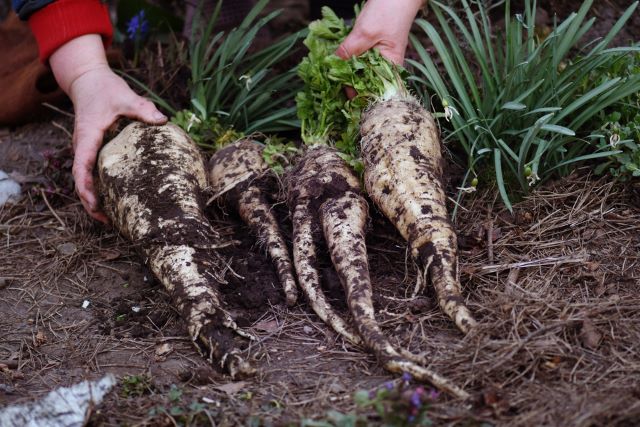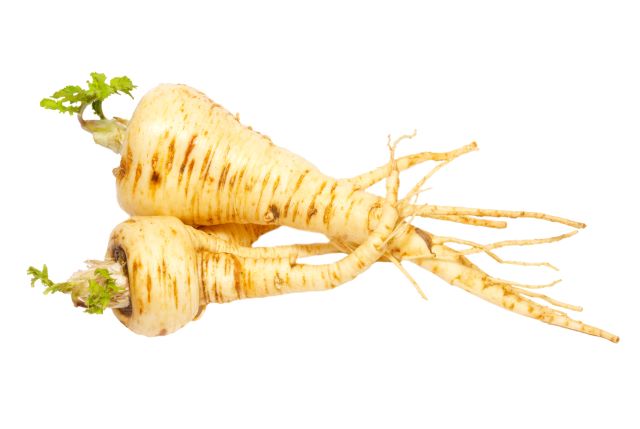Parsnips are a hardy cool-season root vegetable grown for their edible, creamy-white roots. Planted during spring, and developed over the colder months, this relative of carrot and parsley can sometimes end up deformed and misshapen. So if you are wondering why your parsnips are deformed or wonky, you’re in the right place.

Table of Contents
Why Are My Parsnips Deformed?
The most common causes of deformed parsnips include unsuitable soil, inconsistent soil moisture, over-fertilization, crowded plant conditions, weeds, pests, and disease.
You’re not alone if you just dug up your parsnips (Pastinaca sativa), thinking about hearty winter dishes, only to find a mangled, unappetizing stump.
Nothing makes my heart sink faster than looking out at a full patch of parsnips waiting to be dug up while clutching a deformed one in my hand.
I recently harvested around 20 parsnips, and not one had formed correctly, which, as it turns out, is an extremely common occurrence. Root vegetables tend to become twisted, knotted, forked, split, or stunted. Luckily if your parsnip has forked, it is still edible. And unless it is affected by disease, wonky misshapen parsnips can all still be eaten and taste just as delicious as a straight parsnip.
If you are unsure where exactly it all went wrong, read on. Here we explore each reason why your parsnip crop deformed during the growing process, and how to fix them.

1. Unsuitable Soil Conditions
Parsnips are particularly sensitive to soil conditions. If the structure of the soil is wrong, your parsnip, which should resemble a white carrot, will end up forked or split.
Like most root vegetables, parsnips will thrive in loamy or sandy soil. They prefer lighter soil that is enriched with organic material. If the soil in your vegetable patch is heavy and clumpy or filled with rocks and debris your parsnips will be deformed. They will fork while they try to grow around the debris.
To prevent deformed parsnips, you need to properly work your soil. This means making sure your soil is broken up and loose. By tilling and sifting your bed, down to at least 12 inches, and removing rocks and debris as you go, your parsnips have lovely soft soil they can grow down into.
This was why my parsnips didn’t grow correctly, so trust me when I say prepare your soil!
If you have heavier clay soil in your garden beds you can fix it by adding sand and compost or by planting parsnip in raised garden beds.
2. Inconsistent Soil Moisture
If you dig up your parsnips and notice that your roots have split, it is most likely due to fluctuations in your soil moisture. Parsnips need lots of moisture to grow. You will need to make sure you thoroughly water them if the soil dries out.
Splitting roots in parsnips occurs when the soil fluctuates from very wet to very dry. You can place a thin layer of mulch around your plants to help keep the soil moist.
3. Too Much Fertilizer
Another reason your parsnips are misshapen and deformed is due to the use of the wrong fertilizer. If you use a high-nitrogen fertilizer while planting your parsnips, they are more likely to misshapen when you dig up your roots.
Parsnips do not need as much nitrogen as other plants in your garden, such as peppers or tomatoes. So you don’t need to add manure to the soil.
But you can use an all-purpose organic fertilizer mixed into the soil at planting time. Then provided your soil is relatively fertile, parsnips don’t require additional fertilization.
4. Crowded Planting Conditions
If you pull up your parsnips and the roots are deformed and small, have a look at how far apart you have planted them. Parsnips can grow anywhere between 5 to 20 inches (12-50 cm). You should ideally choose a parsnip cultivator (there are hundreds) that grow to a medium length.
Cultivators such as the Harris Model which grows to 10 inches (25 cm), or the All-American which grows between 10 and 12 inches (25-30cm), are great for home vegetable gardens. You should plant parsnips ½ an inch deep, at least 1 inch apart to ensure they have the space they need to grow. Your rows should be between 18 to 24 inches wide (45-60cm).
5. Too Many Weeds
The home gardener’s nemesis, weeds, can often be the cause of deformed parsnips. The reason weeds could be the root of your deformed parsnips is that they also have their underground root system. The weeds and your parsnips end up competing for the same nutrients in your soil, with the weeds often coming out on top, leaving your parsnips misshapen and wonky.
To avoid competition for nutrients, make sure your garden is free from weeds. Keeping your garden clear of weeds will also help to combat other common garden pests.
6. Root-knot Nematode
The most common cause of parsnip deformities is due to root-knot nematodes, which are microscopic parasitic roundworms. These minuscule worms can cause immense damage to home vegetable gardens, and commercial farms alike. They account for 5% of the annual global crop loss.
Root-knot nematodes pierce the skin of your parsnips, so they can lay their eggs inside. A sign you may have root knot nematodes lurking in your soil is if your parsnip plant growth is stunted.
Once you harvest your plants you will notice your parsnip roots are knotty. When the parasitic worms feed on your parsnips, they make the plant cells form galls on the roots.
The galls stop the plant from getting the nutrients and water it needs to thrive, causing stunting and deforming it. The problem with this parasite is that you can only tell if you have them once you have harvested your parsnips.
One way to reduce the likelihood of root-knot nematodes is by overwintering your parsnip plants. This is because root-knot nematodes aren’t as active in cold weather.
Another is to make sure not to plant parsnips where you have previously planted them or where you have planted carrots. Other root vegetables, such as carrots, are susceptible to the parasite. Tilling your soil two to three times a year also helps to prevent these pests.
If you suspect root-knot nematodes, you can also introduce beneficial nematodes by purchasing them which will help rid your garden of root-knot nematodes. Homemade compost and aged manures also encourage beneficial nematodes in your garden.
7. Carrot Rust Flies
One pest that could be responsible for your deformed parsnips is carrot rust flies. This pest will very rarely be spotted in its adult form in your garden. The adults have slim black bodies, yellow legs, and large eyes.
The larvae, which is how you will most commonly encounter this particular garden menace, are a creamy yellow maggot, measuring up to 3/8 inches (9 mm) in size.
Before harvesting your parsnips, if you notice that they seem stunted, the cause could be carrot rust flies. The adult flies lay their eggs in the soil, just under the surface. Once hatched, the maggots start eating the fine root hairs on the parsnip plants. Once those are finished, the tapered maggots tunnel into the roots.
Evidence of the carrot rust maggots damage will be seen when you harvest your roots. You will notice tunnels in your root, that are filled with a rusty brown mushy substance. The parsnip will also be deformed as a result of the pest. These maggots can continue to feed after harvest, so destroying an infected plant is the best practice.
To prevent carrot rust flies you can use sticky traps or floating row covers. If you have previously had a problem with carrot rust flies, do not plant your root vegetable in the same spot.
8. Parsnip Canker
Parsnip canker is a fungal disease that causes the root to rot. This disease is commonly found to affect parsnips when the cooler, damper weather begins. Parsnip canker not only affects the roots, deforming your parsnips through rot, but you may see signs of the diseases on the leaves.
Parsnips are prone to canker, so it is important to look out for the signs, to avoid the disappointment of harvesting rotted, misshapen roots. Parsnip cankers are usually present in the crown or shoulder of the parsnip in the form of reddish-brown cankers.
Sometimes it affects the leaves of the parsnip plant, which resembles leaf spot. If the disease progresses, it will cause the root to rot. Parsnip cankers usually develop in parsnip plants that have a carrot rust fly infestation.
The way to prevent this parsnip-deforming fungus is to prevent carrot rust flies from infesting your vegetable patch. Keeping your plants covered with floating row covers, and ensuring your garden is free from weeds will do the trick.
Further Reading:
- Are Carrots a Fruit or a Vegetable? Answered!
- Planning a Square Foot Garden for Abundant Vegetables
- 13 Beet Pests Eating Your Crop (With Organic Solutions)
- Turnips Vs Radishes: What’s The Difference?
- Parsley Dying? 6 Common Causes and Solutions
- A Twisted Tale: 8 Causes of Deformed Carrots with Solutions
